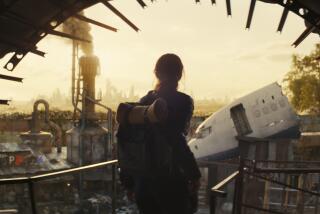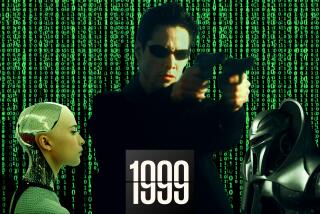The ‘Matrix’ in the middle
- Share via
Let’s start with all the things “The Matrix Reloaded” is:
* the highly anticipated sequel to one of the most influential, admired (four Academy Awards) and popular (nearly half a billion dollars in worldwide theatrical gross) of films;
* the first part of a simultaneously shot two-picture conclusion to the original (the second part, “The Matrix Revolutions,” comes out in November) that together cost upward of $300 million and has taken four years to come to the screen;
* an elaborately choreographed, rigorously stylized science-fiction epic rife with cool heroes, intriguing villains and eye-widening action set pieces that show us the money in no uncertain terms.
Saying what “The Matrix Reloaded” isn’t turns out to be a lot less complicated: It’s simply not as satisfying as the original.
Even the return of stars Keanu Reeves, Laurence Fishburne and Carrie-Ann Moss, as well as writer-directors and conceptual godfathers Larry and Andy Wachowski, can’t change that.
While that reality might be predictable -- and, to a certain extent, unavoidable for the follow-up to a film that changed the face of what we expect from this kind of escapist entertainment -- it’s still a disappointment and one that illustrates the limitations of cool as a defining and sustaining style.
Yes, the Wachowskis had more money and more complex effects to play around with this time, but on the debit side, what could possibly compensate for the loss of the you’ve-never-seen-this-before excitement the first one delivered.
Another built-in source of frustration is a kind of “Malcolm in the Middle” syndrome. While the first “Matrix” was enhanced by the classic drama of the making of the hero Neo from humble clay, and the third one will presumably have the drive of a powerful can-humanity-be-saved conclusion, middles are almost by definition less compelling and trickier to make involving.
There are several characters, like Jada Pinkett Smith’s warrior Niobe, who seem to be embedded here for greater use in Part 3, and there’s less at stake in the film’s outcome because we know the story doesn’t really end here. Good intentions and great effects notwithstanding, in dramatic terms this is basically an expensive place holder, a rest stop where the narrative can catch its breath before moving on.
The Wachowskis, to their credit, are clearly aware of these pitfalls, and they do everything in their considerable power to mount a vigorous counterattack. Their strongest weapon, now as always, is the power and complexity of their vision, their belief in and passion for the alternative universe they have created and nurtured to the smallest detail like twins creating their own private language. Theirs is a world real enough to walk around in, real enough to have spun off a concurrent short film collection called “The Animatrix,” and that makes a considerable difference.
Another weapon is the cleverness of the trilogy’s originating concept, the notion that the real world is a computer-generated dreamscape, a virtual reality concoted by machines to distract us while our bodies are being plundered as an energy source less troublesome than Middle Eastern oil.
As the first film concluded, Neo (Reeves), after being anointed by Morpheus (Fishburne) and loved by Trinity (Moss), came to accept his position as the One, a human destined to liberate his species from artificial-intelligence bondage. But if that was going to be easy, a three-part movie wouldn’t be necessary.
“Reloaded” begins with the gang returning to the underground city of Zion, where all the world’s already-freed humans live, but where not everyone is convinced that Neo is the One or even that the prophecies are real. Making things that much more urgent is that the machines have sent an attack force of 250,000 nasty Sentinels who will reach Zion in 72 hours and attempt to destroy these pesky rebels once and for all.
In an attempt to stop the attack, Neo must reconsult the prophesizing Oracle and follow her maddeningly murky directions while fending off attacks from all kinds of inhuman individuals up to no good, including Agent Smith (Hugo Weaving), who has returned with even greater powers.
In telling this story, the Wachowskis once again lean on the things that made the first one so successful, though there is now a sense that, not realizing you can have too much of a good thing, they’re in danger of leaning on them too hard. There is, for instance, now so much style evident in clothing and accessories, it sometimes seems that what this whole movie is about is having the right sunglasses.
There are also more characters whose names come with associations from mythology (Persephone, Niobe), Japanese cinema (Mifune), European history (the Merovingian), and the Old Testament (Zion, Nebuchadnezzar), the last of which underlines how much of an unacknowledged Christ figure the anointed Neo is made out to be, complete with a battle-hardened John the Baptist in Morpheus.
Also worth noting is the Wachowskis’ extensive (and welcome) use of color-blind casting. Starting with Fishburne and Pinkett Smith, a good half-dozen key heroic roles are taken by African American actors, and that doesn’t include cameos from boxer Roy Jones Jr. and Harvard scholar Cornel West.
Without the newness of the concept as a lure, “Reloaded” increasingly relies on elaborate action and new villains (Monica Bellucci as Persephone, Lambert Wilson as the Merovingian, Adrian and Neil Rayment as evil twins) to keep us interested. On the combat side, there is a stirring battle involving cars, trucks, motorcycles and martial arts on a replica of the Harbor Freeway, built at no small expense in Northern California (the real one is kinda busy). Also on tap is a much-talked-about scene where Neo takes on something like a hundred replicas of scheming Agent Smith.
Yet, just as these computer-generated replicas feel more mechanical than threatening, the intentional coldness of “Reloaded” also does not wear well. Though it suited the original “Matrix” and remains a good match for this film’s “I know because I must know,” Zen philosophizing, its limitations become more apparent as its reach is stretched over a second film.
If a concept is to sustain itself over a multipart story, it must make an emotional connection, and this “Reloaded,” especially with stars cast for their lack of affect and affinity for blankness, cannot do that.
Perhaps sensing this, the Wachowskis have attempted to put more texture into “Reloaded,” giving us an extended glimpse into life in Zion and throwing in a candlelit love scene between Neo and Trinity free of charge. It’s a good try but doomed. Whether anyone likes it or not, everyone is finally a prisoner of this aesthetic of cool.
An example of a comparable trilogy that managed to avoid this pitfall is, obviously, “The Lord of the Rings.” “The Two Towers” potentially had similar middle-child problems, but its use of characters like Miranda Otto’s Eowyn and the troubled Gollum to involve our feelings made a considerable difference. It’s typical of “Reloaded’s” core difficulty that when a character sneers at a rival, “still using all the muscles except the one that matters,” he’s referring to the head, not the heart.
*
‘The Matrix Reloaded’
MPAA rating: R, for sci-fi violence and some sexuality
Times guidelines: The violence is relatively tame for the genre; there is lots of action but little blood, and the sex is muted.
Keanu Reeves...Neo
Laurence Fishburne...Morpheus
Carrie-Anne Moss...Trinity
Hugo Weaving...Agent Smith
Jada Pinkett Smith...Niobe
Gloria Foster...The Oracle
Warner Bros. Pictures presents, in association with Village Roadshow Pictures and NPV Entertainment, a Silver Pictures production, released by Warner Bros. Written and directed by the Wachowski Brothers. Producer Joel Silver. Executive producers Andy Wachowski, Larry Wachowski, Grant Hill, Andrew Mason and Bruce Berman. Cinematographer Bill Pope. Editor Zach Staenberg. Costume designer Kym Barrett. Music Don Davis. Production designer Owen Paterson. Visual effects supervisor John Gaeta. Running time: 2 hours, 18 minutes.
In general release.
More to Read
Only good movies
Get the Indie Focus newsletter, Mark Olsen's weekly guide to the world of cinema.
You may occasionally receive promotional content from the Los Angeles Times.











